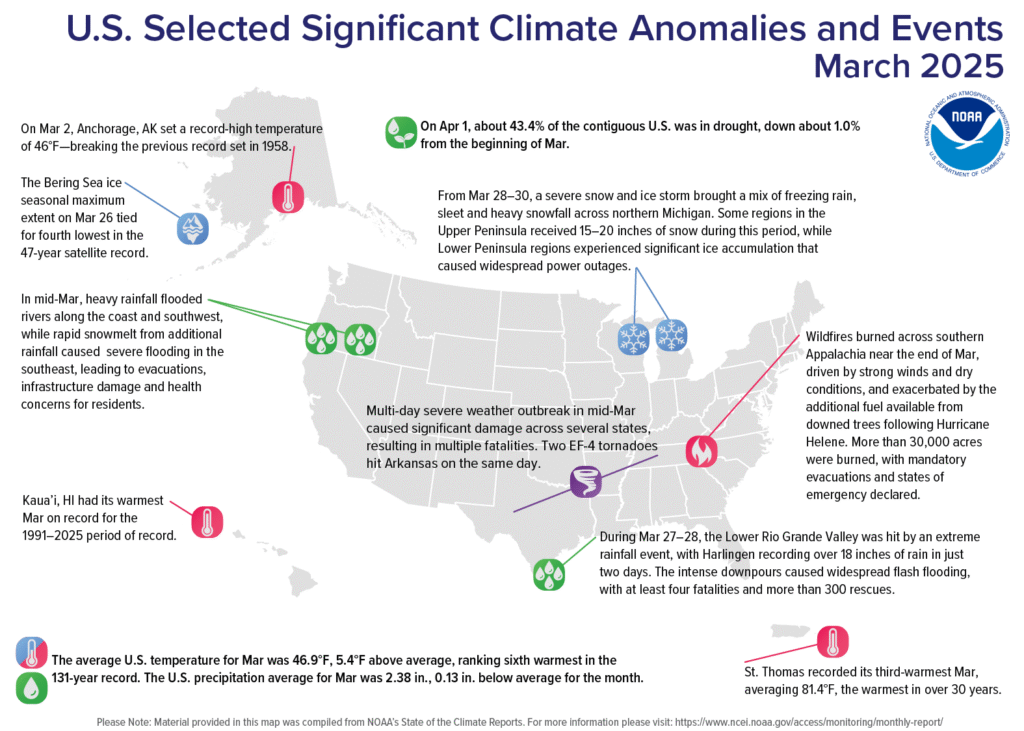March 2025: A Weather Overview of Severe Events and Climate Anomalies
March 2025 will be remembered for its dramatic and severe weather events across the United States, from devastating tornadoes to expansive wildfires. Key incidents in this month highlighted the ongoing climate challenges the nation faces. Here’s a detailed exploration of these critical occurrences, along with insights into temperature and precipitation patterns throughout the month.
Severe Weather Outbreak
In mid-March, the U.S. experienced a catastrophic severe weather outbreak that spanned multiple states, including Texas, Arkansas, and Tennessee. This intense weather system resulted in substantial damage, leading to multiple fatalities. Notably, two EF-4 tornadoes struck Arkansas on the same day, causing widespread devastation. Such severe weather incidents emphasize the necessity of enhanced preparedness and response measures in areas prone to tornado activity.
Wildfires in Southern Appalachia
Simultaneously, parts of southern Appalachia faced devastating wildfires, exacerbated by strong winds and dry conditions. Over 30,000 acres burned as additional fuel was made available from downed trees due to Hurricane Helene. This situation underlines the importance of fire management strategies and emphasizes the growing threat of wildfires in the region, particularly during periods of drought.
Temperature Trends
March 2025 recorded the sixth-warmest March on record for the contiguous United States. The average temperature during the month was a notable 46.9°F, which is 5.4°F above the historical average. Most of the Lower 48 states experienced above-average temperatures, with Kansas experiencing its fourth-warmest March in history, tied with 1946. Nebraska and Texas also recorded significant warmth, marking their fifth warmest March.
In contrast, Alaska recorded a statewide average temperature of 16.7°F, placing it in the warmest third of the last 101 years. Exceptional warmth was also noted in Southcentral Alaska and the North Slope. Meanwhile, in Hawaii, March temperatures reached an average of 64.8°F, 1.3°F above the long-term average, with Kaua’i marking its warmest March on record.
Precipitation Insights
The total precipitation for March across the contiguous U.S. stood at 2.38 inches, slightly below the average, ranking in the middle third of the historical record. Several regions, especially in the northern and southern Plains, and some parts of the Rockies and central Mississippi Valley, experienced below-average precipitation. Notably, West Virginia faced its fifth driest March, while Michigan and Wisconsin recorded their second and fifth wettest Marches, respectively.
In Hawaii, the average rainfall was 4.23 inches, which marked a significant deficit of 2.62 inches below the average. For the January to March period, the average contiguous U.S. precipitation totaled 5.92 inches, indicating a trend towards drier conditions across key regions.
Drought Situation and Outlook
As of April 1, about 43.4% of the contiguous U.S. was in drought, a slight improvement from earlier in March. Drought conditions worsened in the Southwest and southern Plains, while improvements were noted in parts of the northern Rockies and the Great Lakes. This ongoing drought issue highlights the need for consistent monitoring and responsive strategies.
Monthly Weather Outlook
Looking ahead, forecasts indicate that above-average temperatures are likely throughout the Southwest, extending to the Southeast. Drier conditions are expected in several regions, including the Southwest and the Florida Peninsula, while the south-central Plains and Ohio Valley may see increased rainfall.
As we move into April, the potential for significant wildland fires remains above normal in regions across the Southwest and southern Plains. Continued vigilance and preparedness are crucial as these climatic shifts evolve.
For more insights on the climate and weather events of March 2025, you may visit the comprehensive U.S. Climate Report scheduled to be released on April 11, 2025. Additionally, detailed statistics can be explored through the Climate at a Glance and National Maps resources for a deeper understanding of these weather phenomena.
March 2025 stands as a reminder of the importance of resilient infrastructure and community preparedness in facing the increasing severity of weather events driven by climate change. Stay informed and prepared as we continue to monitor and adapt to these environmental changes.


